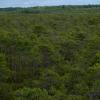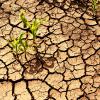
In a new study published in Global Environmental Change, an international team of researchers from seven institutions, including IIASA, developed a first of its kind forest model intercomparison project (ForMIP) to estimate long-term futures for the world’s forests under different socioeconomic and climate mitigation pathways.
Amid growing recognition of the important contributions of the global forest sector to the carbon cycle and climate change mitigation, the researchers highlight the need to understand the combined impacts of the market, management, and policy changes on forest carbon stocks and greenhouse gas emissions. The study addresses key knowledge gaps related to the influence of climate change policies on forest management and timber production; the role of timber demand on land carbon fluxes; and regional trends in forest area, carbon sequestration, and market outcomes.
“Our research highlights the importance of capturing the influence of the socioeconomic drivers of forest management at multiple scales,” explains University of Maine Associate Professor of Forest Policy and Economics, Adam Daigneault, the lead author of the study. “The ForMIP study provides a prime example of how these important drivers of forest regrowth and dynamics can be projected into the future, and the implications that such assumptions have on carbon stocks through 2100.”
Modeling several dozen future socioeconomic and climate policy scenarios across three forest sector models enabled the researchers to offer important insights concerning forest climate mitigation investments and policy design. Their results highlight the contributions that existing forests play in our global carbon balance, and how policy and economic development trends drive both forest management change, forest preservation, and new tree planting.
“Forests play a central role in climate mitigation, biodiversity protection, and circular bioeconomy. However, most studies about forests have a one-sided perspective, ignoring the multiple roles of forests. In this study, we compared the outcomes of three global forest sector models, which can be used to analyze trade-offs between different uses of forests and forest-based resources. One of these models is the IIASA Global Biosphere Management Model (GLOBIOM), which is maintained by the IIASA Integrated Biosphere Futures Research Group,” notes IIASA researcher, Pekka Lauri, a study coauthor and main developer of the GLOBIOM forest sector module.
A key finding of the research is that economic growth and increased demand for traditional forest products and bioenergy do not necessarily lead to forest carbon loss. Investments in forest management driven by market signals can in fact lead to faster growing forests that can jointly sequester more carbon and provide ample timber supply.
The paper has direct and immediate policy relevance at both the regional and global scale. ForMIP’s use of high-resolution models of forest ecosystems and markets accurately ascertains the forest sector mitigation potential – a key element of many countries’ commitments to using forests to mitigate climate change. The research helps fill two key gaps: (i) a framework for policymakers to better understand and align national results for goal setting greenhouse gas stock take efforts, and (ii) to better inform global analyses of mitigation possibilities that more adequately reflect forest sector dynamics. According to the researchers, the research will enable more rigorous and informed assessments of global and regional mitigation pathways.
Concluding on a hopeful note, the model scenarios indicate a consistent positive trend in forest carbon stocks and timber supply through 2100, reflecting the importance of carbon dynamics on existing forests and the potential gains that can be captured through forest management. The study indicated that global forests could sequester 1.2–5.8 gigatons of carbon dioxide equivalent per year over the next century, thereby offsetting up to 18% of current global energy emissions.
Adapted from a press release by the University of Maine Center for Research on Sustainable Forests. Read the original article here.
Reference
Daigneault, A., Baker, J.S., Guo, J., Lauri, P., Favero, A., Forsell, N., Johnston, C., Ohrel, S.B., Sohngen, B. (2022). How the future of the global forest sink depends on timber demand, forest management, and carbon policies. Global Environmental Change 76, 102582. DOI: 10.1016/j.gloenvcha.2022.102582
News

07 May 2024
TaigaClimate Project Meeting 2024

25 April 2024
Climate change could become the main driver of biodiversity decline by mid-century

23 April 2024
